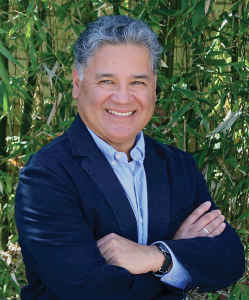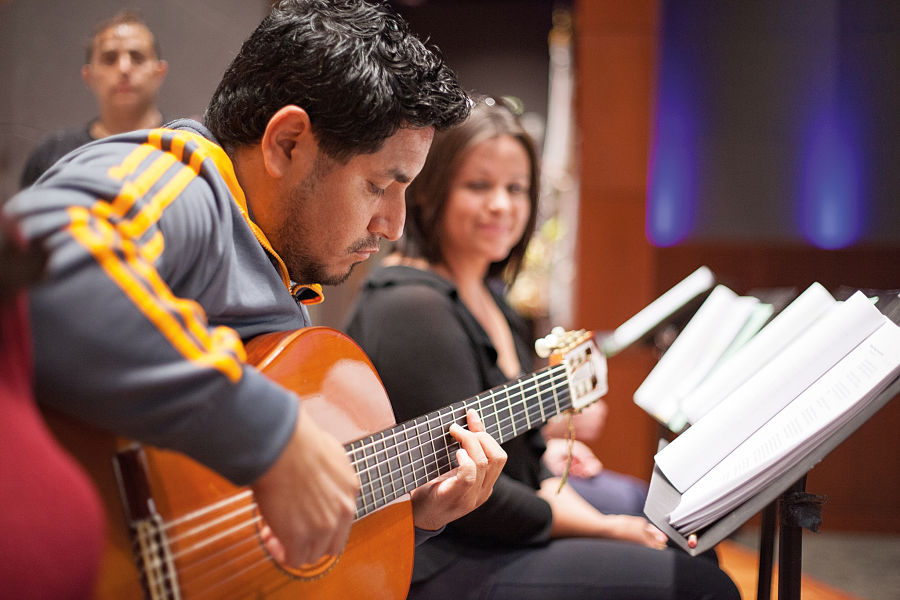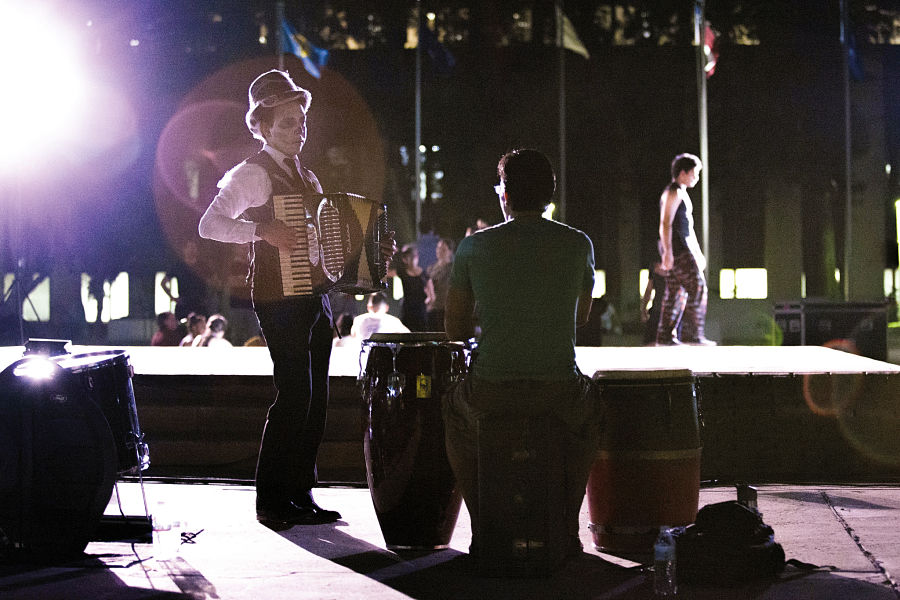No one expected South Coast Repertory’s new strategic plan to shift into action quite as quickly as it did. But when you say “yes” to a vision of community-engaged theatre, the pieces fall into place as if the world had been waiting.
“What is it to be a regional theatre today? What is our relationship to our community, and how has that community changed over the years?” Those were questions on Marc Masterson’s mind when he took the reins of SCR three-and-a-half years ago, and they provoked a lively conversation among the Costa Mesa, Calif., company’s board members and artistic staff.
Masterson’s involvement in community-engaged work dates back to the 1980s in Pittsburgh, when City Theatre, which he led for almost 20 years, partnered with social-service organizations to create original work. His first impressions of the economic disparities in Orange County immediately brought those Pittsburgh experiences to mind: As the first new artistic director of SCR since David Emmes and Martin Benson founded the company 50 years ago, could he steer the organization toward arts-based community-building, social healing and urban renewal?
Managing director Paula Tomei, who has been with the company since its nascent days, joined with Masterson to craft a strategic plan that gave priority to just those aims. “SCR grew up with the regional theatre movement, which was about serving diverse communities across the country,” she says. “How can we reclaim that vision?”
Almost as soon as the theatre’s new strategic plan emerged, so did the means to implement it—a $600,000 grant from the James Irvine Foundation’s Exploring Engagement Fund. “They were calling for projects that engaged low-income or ethnically diverse populations that have been historically underserved by arts nonprofits,” Masterson recalls.
“They wanted us to take big risks—bold, new experiments,” Tomei chimes in. “It was a tight turnaround to line up community partners, artistic staff and a project plan, but we went for it. We said yes.”
The purpose of the grant, Masterson clarifies, was not audience development but rather “making a piece of art.” And the convergence of a visionary funding source with far-sighted artistic leadership resulted in the creation of Dialogue/Diálogos, a two-year partnership with Latino Health Access of Santa Ana, Calif., during which hundreds of primarily Latino residents would work with SCR artists to tell the story of their community.

That’s how The Long Road Today / El Largo Camino de Hoy came to fruition in September 2014. Written by José Cruz González, this epic, site-specific, multimedia production with a cast of more than 60 actors, musicians and dancers was staged by Armando Molina in and around Santa Ana’s Civic Center. Its production and development process forged a new road of community engagement for South Coast Rep.
Santa Ana is 78 percent Latino—it has the largest Mexican-American community (over 200,000) in the U.S, and in 2004 was rated among the top cities in the nation by the Los Angeles Times for “urban hardship,” a term measuring unemployment, low education, poverty and density. It’s also a young city, with a median age of 29. Gang violence and poor health among young people are exacerbated by a lack of open space. In the past decade, Santa Ana has seen a burgeoning of grassroots efforts to create change. Yet, while Orange County’s affluent communities—Irvine, Newport and Costa Mesa—celebrate the wide open spaces of golf courses, beaches, mountain-bike trails and planned communities, Santa Ana has few parks and little space for children to play. Even vacant lots and schoolyards are fenced and locked.
Latino Health Access has 21 years of success advocating for and educating community members about health care, parenting, addiction and pathways to citizenship. CEO América Bracho (who was featured in 2009 on PBS’s Bill Moyers Journal) was already hip to the way the arts can be an effective part of community-building and empowerment. But even with a savvy community partner, SCR’s well-oiled production machine did not have all the expertise it needed to engage community members in telling its stories through theatre.
But Masterson and company knew some folks who did. “We have a resource just up the freeway in Cornerstone Theater,” he said, and proceeded to contact Michael John Garcés, Cornerstone’s artistic director (acclaimed for his 2007 Los Illegals, developed with Latino day laborers in Los Angeles). “We needed to build structures that facilitated listening,” Masterson allows, “and one of the key principles in community-based theatre is letting the community guide the process.”
SCR pulled together a project team, calling particularly on current and former SCR staff and artists who had relationships with the Latino communities of Santa Ana. The lineup included González, former director of SCR’s Hispanic Playwrights Project from 1985 to 1996; director Molina, a longtime ensemble member at Cornerstone, now artistic director of Company of Angels Theater; and Sara Guerrero, SCR education staffer and artistic director of Breath of Fire Latina Theater Ensemble. Meanwhile, Bracho sought out key members in her own organization, designating Moisés Vázquez as LHA’s liaison to Diálogos.
“A project like this,” Tomei points out, “runs the risk of being a satellite, and we didn’t want that. The first thing we did was invite Cornerstone to do training for SCR staff, our community partners and the Diálogos team.” This was the moment that set the tone and established the structures of listening that the project would use over the coming two years.

“We had our first story circle,” Vázquez remembers. “We did theatre exercises, sang songs and told our stories. Those stories became the foundation of our work together.” For those new to Cornerstone’s time-tested methods, the training was revelatory. SCR associate artistic director John Glore echoed an organization-wide buy-in after the workshop, declaring, “Okay, now I get it! I see what this project is about!”
The project team also identified a group of 10 bilingual teaching artists. “It turned out that we had those people either on staff or in our artistic connections, many as a result of the 14 years of the Hispanic Playwrights Project,” Masterson notes. Over the next two years these teaching artists became the heartbeat of the project’s engagement with Santa Ana. They facilitated story circles, taught workshops, worked with González and Molina in devising sessions, then transitioned into key production positions when rehearsals began.
LHA liaison Vázquez, meanwhile, drew on his organization’s history of trust and connection in the community. “We are a door-to-door organization. We go out and talk to people,” he explains. Charged with “selling the project to the community,” Vázquez remembers that “at first folks were hesitant to come and share their stories. So I invited them to come listen to other people’s stories—and that worked. People wanted to come and hear the stories of their community, to share food and songs.” At LHA, he adds, “we’re used to figuring out what it is people need—if it’s childcare, we provide childcare. If they need dinner because they are coming right after work, we make sure there’s food. In fact, we always have food!”
Diálogos took on a life of its own as story circles blossomed in community centers, libraries, at Santa Ana Community College, and at Latino Health Access. “Each geographic space also represented a different social space,” Molina points out. The first storycircle attracted over 80 people. González explains, “We started with ice-breakers—theatre games that brought people into relationship. We shared our own stories, and then introduced questions to draw out and focus people’s stories and feelings about their place, about Santa Ana. What is a place of beauty in your community? What is a place of mystery? What is a place of fear? What are your dreams for Santa Ana? We gave people paper and markers to draw, write or map their responses. At the end of the evening, we’d come back together and talk about common themes.”
Vázquez recalls, “The teaching artists became José’s eyes and ears. We listened for him to the themes and concerns that were emerging from the community.” González also personally interviewed more than 500 people, gathering stories for the play.
Community members became increasingly curious about just how their stories would become a play, so SCR set up free workshops in acting, improvisation, musical theatre, stage combat, voice and puppetry, taught by the Diálogos teaching artists. These “share-backs” helped bridge the skills gap between community artists and professionals, and demonstrated the power of theatre.
Angela Apodaca (who performed the role of El Diablito) remembers a workshop in stage combat in which “a woman participating had experienced domestic violence. In the workshop we were learning to create the illusion of violence, which opened a space for her to share her story about actual violence and the emotions associated with her experience. We all became more aware of what people go through. We saw her push through her fears.”
For González, writing The Long Road Today / El Largo Camino de Hoy “brought together the different ways of telling stories that I’ve used over the years—not only English and Spanish text, but puppets, toy theatre, shadow play, media, music and dance.” As the first truly bilingual production SCR has done (with actors as well as audiences who spoke only Spanish as well as some who spoke only English), visual storytelling and music became fundamental. “We had to constantly think about how much dialogue would be in English, how much in Spanish, what needed to be said in both—what would be understood through visual aspects alone.”
The play follows two families, fictional composites of hundreds of stories: One family’s little boy is killed by a passing car while he plays soccer in the street; the other family’s teenage son was driving that car. The story unfolds through a series of loosely woven scenes that move forward and back in time, through the devastating loss of a child to death or incarceration, back to the dreams of a family panadería, into a child’s daydream of a park in which to play, a hipster’s encounter with a neighborhood tamales seller, or a women’s sewing circle that rises into activism for a new park. González envisioned the audience walking through 16 parallel scenes in four groups, led by guides based on the familiar characters of Lotería, a traditional game of chance much like Bingo. It didn’t matter in what order audiences viewed the scenes: We enter our circumstances by chance; it’s how we respond that matters.
González saw possibilities among the imposing government buildings of Santa Ana’s Civic Center: intimate gardens, quiet nooks linked by walkways, ceremonial spaces like the Plaza of the Flags, and a large circular fountain. “It all came together when I saw the fountain—the water became the Lake of Tears where La Luna would comfort the mothers in the play.” For some community members in the cast, however, the Civic Center was a place of fear. “It’s not a place we go,” Vázquez points out, “except when there’s a protest about immigration or gay rights or something like that. Generally, people don’t have a good feeling about that place.” And it has ghosts: The library was built atop a graveyard, where some cast and audience have relatives buried.
When the production moved to on-site nighttime rehearsals, “we realized we were displacing homeless people who lived there,” recalls González. The significance was not lost on performers. “We had someone in the show who had to drop out because he lost his housing and became homeless. His situation gave us compassion for how close we all live to that edge,” Apodaca notes.
For Molina, charged with staging 18 scenes that ran simultaneously on 4 tracks through 8 locations, the Civic Center was definitely a character in the play. The production, free to the public, opened Sept. 18 to an audience of 150; by closing night, Sept. 28, that number had grown to 450.
Excitement was palpable on the evening I attended, as crowds of Santa Ana residents (and some SCR subscribers) gathered for a story that would overtake and transform the Civic Center. This was a community celebration. Large families carried lawn chairs as if to a parade; there was none of the typical hushed reverence of an elite theatre-going audience. Not long after the production closed, its theme song, “The People of My City / La Gente de Mi Ciudad,” became the official song of the City of Santa Ana. Whether plans for turning fenced-off vacant lots into public parks will emerge, only time will tell. “I think it’s given advocates and city official more resolve to make that happen,” Vázquez believes.
Intercultural director Rustom Bharucha is fond of asking, “When the play ends, what remains?” And, “When the play ends, what begins?” At the end of this long road, what remains includes ongoing friendships, newly envisioned public spaces inscribed with memories, knowledge and skills gained through accomplishment, personal transformations, and dreams of future collaborations. “It’s not like a typical show where you strike, and then everyone’s on to something else. This is our home” says Guerrero.
What begins? Masterson points to SCR’s new CrossRoads Commissioning Project, a community-based initiative that partners eight playwrights with community organizations in Orange County (made possible by Time Warner Foundation), and the possibility of continuing theatre workshops for adults in Santa Ana. Poet Antonio Machado sums up the possibilities in a phrase: “We make the road by walking.”
Theresa May is a playwright/director and associate professor at the University of Oregon.


